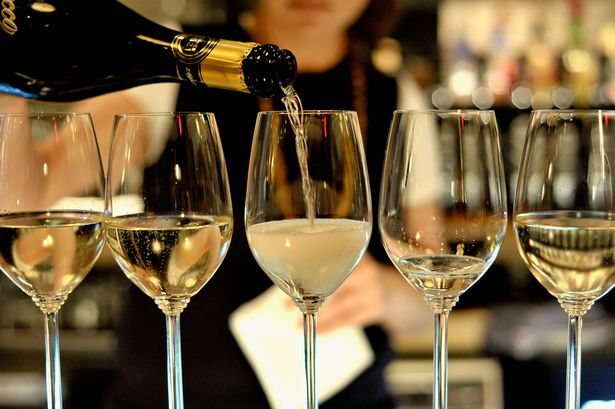Champagne (/ʃæmˈpeɪn/, French: [ʃɑ̃paɲ]) is a French sparkling wine. Many people use the term Champagne as a generic term for sparkling wine, but in the EU and some other countries, it is illegal to label any product Champagne unless it came from the Champagne wine region of France and is produced under the rules of the appellation.[1] This alcoholic drink is produced from specific types of grapes grown in the Champagne region following rules that demand, among other things, specific vineyard practices, sourcing of grapes exclusively from designated places within the Champagne region, specific grape-pressing methods and secondary fermentation of the wine in the bottle to cause carbonation.[2]Vineyards in the Champagne region of France
The grapes Pinot noir, Pinot meunier, and Chardonnay are primarily used to produce almost all Champagne, but small amounts of Pinot blanc, Pinot gris, Arbane, and Petit Meslier are vinified as well. Only these specific grapes grown according to appellation rules on designated plots of land within the appellation may be used to make Champagne.
Champagne became associated with royalty in the 17th, 18th, and 19th centuries. The leading manufacturers made efforts to associate their Champagnes with nobility and royalty through advertising and packaging, which led to its popularity among the emerging middle class.[1]

A brief history
Champagne as we know it was the product of both chance and circumstance. Early wine from the region was pale pink and still. The region’s cold winter temperatures often halted the fermentation of still wines housed in the cellars. The dormant yeast cells remained in limbo until warmer weather provoked an awakening. In spring, these yeast cells sparked a second fermentation in the wines, where the remaining sugar was converted to alcohol. The byproduct of that fermentation, carbon dioxide, remained trapped in the bottles and would force out corks or cause bottles to explode.
In the mid-1600s, a Benedictine monk named Dom Pérignon, frustrated with the waste brought forth by such instability, took efforts to stop this fermentation. Perignon’s first contribution was to introduce a blending technique where grape varieties from different vineyards were used to create a single wine. He also developed a way for winemakers to produce white wine from red grapes. That method, like his blending technique, remains integral in Champagne production centuries later.
Around the same time, English physicist Christopher Merret discovered that the introduction of sugar could intentionally spur a second fermentation. It gave winemakers control of this unpredictable, and seemingly random, scientific occurrence. This immeasurable contribution meant that winemakers could create sparkling wine on purpose.
In 1805, Madame Barbe-Nicole Clicquot, a 27-year-old French widow, assumed control of her late husband’s Champagne house. During that time, Madame Clicquot, also known as the veuve, French for “widow,” developed a process known as riddling, or remuage. In this process, wines are moved to bring the dead yeast cells from the second fermentation into the bottle’s neck, where they can be extracted. Prior to this, sparkling wines were cloudy with large bubbles. The technique yielded wines with small, fresh bubbles, known as a mousse, and no sediment.
